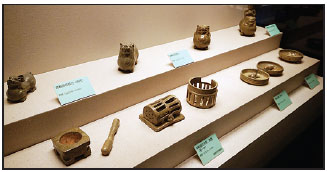Collector's generosity gives porcelain lovers rare historical treat
|
Part of Chen Guozhen's collection is on display at the Palace Museum in Beijing to show visitors how Yue kiln celadon developed and its role in the beginnings of Chinese porcelain.Wang Kaihao / China Daily |
More than 30 years ago, Chen Guozhen, 68, an entrepreneur and private collector from Yuyao, in Zhejiang province, started to collect porcelain made at the Yue kiln, an ancient production hub in his hometown.
But never could he have imagined that his collection - now one of the country's biggest private reserves of such cultural relics - would one day be displayed at China's top museum.
A part of Chen's collection, which includes more than 7,000 articles, is now on display at the Palace Museum in Beijing to show visitors how Yue kiln celadon developed and its role in the origin of Chinese porcelain.
The show, which opened last week, is titled Moon Shines over the Autumn River: The Celadon Collected and Donated by Chen Guozhen.
The show has 153 sets of celadon on display, and 19 of them have been donated to the Palace Museum, also known as the Forbidden City, by Chen. His main collection has been on display at the East Zhejiang Yue Kiln Celadon Museum, which he set up in 2006.
"I've almost thrown away all I've earned to celadon," Chen says, giving his reason for sharing his collection with the public.
"Many people enter the collection circuit to invest and thus follow fads. However, if you want to be a successful collector, individual pain should give way to the inheritance of tradition. We're only temporary custodians of these treasures, which belong to history," he says.
According to Geng Baochang, 93, a veteran porcelain researcher from the Palace Museum, a prototype of celadon can be traced back to the 11th century BC in the east of the Zhejiang province. In the late Eastern Han Dynasty (AD 25-220), the area produced the world's earliest chinaware after a long time spent on development of the technique.
The Yue kiln reached its peak in the Tang Dynasty (AD 618-907), when its mise (secret color) porcelain was used exclusively by royal families.
"The maritime Silk Road also gave Yue kiln celadon a chance to be exported overseas," Geng says. "The technique had direct influence on those of the Korean Peninsula and Japan."
As China's former royal palace, the Palace Museum now houses 367,000 articles of porcelain. But Shan Jixiang, the director of the museum, admits that its collection is not complete in spite of its huge size.
"For example, the museum's collection of porcelain from southern China is lacking because the focus is mainly on the most renowned kilns in ancient China, which are mostly in the north."
The museum's academic institute has also gathered samples of ancient porcelain from over 100 kiln relics nationwide, but the director says most of the samples are broken pieces.
The celadon articles displayed this time are not only exhibits, but important references for studies, he says.
"We have to rely on more private efforts to get a complete picture, and this exhibition is an attempt," says Shan.
wangkaihao@chinadaily.com.cn



















